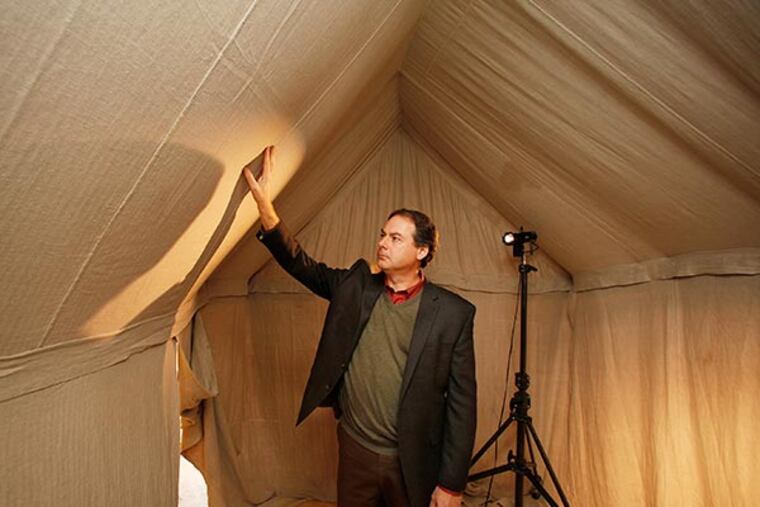Re-creating the wartime shelter of Washington
Cold infused the large hall. No heat on a winter's day. But for those working to erect a large tent within the building, temperature did not matter.

Cold infused the large hall. No heat on a winter's day.
But for those working to erect a large tent within the building, temperature did not matter.
Their focus was on the task at hand - the first rollout and setup of a made-to-order replica of George Washington's field tent, his wartime "marquee," an icon of the nation-to-be.
The Museum of the American Revolution, which now owns the visitor center at Third and Chestnut Streets and plans to demolish it to erect a new museum, had the replica made to determine how best to erect and display the original, now a fragile relic.
On Tuesday, the replica, an oval roughly 22 feet long and 15 feet wide, was unfolded and draped over a new, umbrella-like substructure. Sides went up shortly thereafter. (The public can view the display and speak with the design team Friday from 11 a.m. to 2 p.m.)
Years of research and design went into the moment, which went off with few hitches.
"The point of this," said Michael C. Quinn, museum president and chief executive, "is that this is our stunt double."
R. Scott Stephenson, director of the museum's collections, also looked on as five conservators and crafts workers stood on a hydraulic lift to reach the tent peaks, topped with wood finials and about 13 feet off the ground. He said the use of the "stunt double" allowed the original to remain resting peacefully in storage in Phoenixville.
It will not be needed until it becomes the central display in the new museum, projected to open in late 2015.
"We needed to find a way to erect this fragile object without putting any stress on it," Stephenson said.
Conservationist Virgina Whelan said the original "does need conservation treatment."
"This is an icon of our country," she said, "and we want it to remain intact for centuries to come."
The ingenious "subtent" - poles supporting umbrellas - means the original tent simply lies on top and drapes down. The subtent will be hidden, helping to lend the appearance of a tent stretched tight and attached with rope, without the potential for damage.
"With the actual original structure, you'd have poles and ropes here that would stretch it out," Stephenson said. "It's an ancient design that goes back to classical Greeks and Romans."
The faux tent took about four years of research to construct, said Mark Hutter, a tailor supervisor from Colonial Williamsburg. Hutter oversaw construction of the tent in Williamsburg, Va., last summer.
"It's deceptively simple," he said of the construction. "But a tremendous amount of very careful geometry allows this thing to assume its shape and maintain stability."
"This is a building," he added.
Workers in Reading built the original tent for Washington while he was camped at Valley Forge in 1778. It served as the central element of his field encampment, the place to which he retreated to read, write, and sleep.
The external emblem of his generalship traveled with him for the remainder of the Revolution and was used during the Siege of Yorktown, where the British surrendered.
After Washington's death in 1799, the tent passed into Martha Washington's possession. It was purchased from her estate by her grandson, George Washington Parke Custis, who stored it at his Virginia estate, Arlington House.
Custis' daughter, who was married to Gen. Robert E. Lee, kept the tent, which was seized from Arlington House by federal troops at the end of the Civil War. It was eventually returned to the Lee family and was sold around 1907 to W. Herbert Burk for about $5,000. Burk used it as the central artifact of the Valley Forge Historical Society, whose collection is now in the possession of the Museum of the American Revolution.
When it is on display in the museum, the tent will be encased and used in a theatrical presentation.
"It represents Washington," said Quinn. "Its story is of his scrupulous regard for civilian rule, even though more than once he had the opportunity to become emperor. . . . It's that kind of integrity that this tent represents."